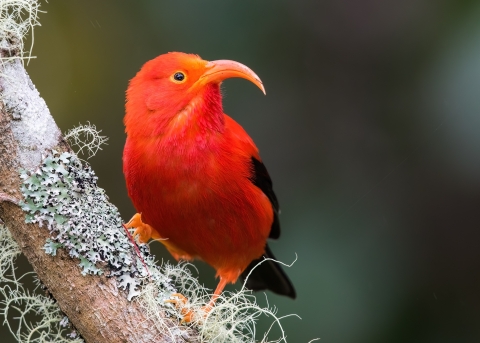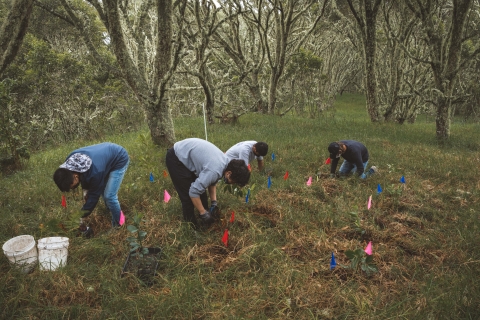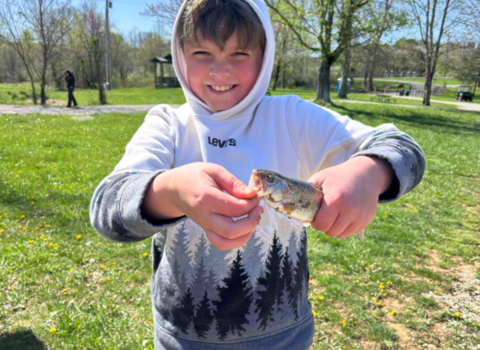Birds’ ability to fly to remote island habitats have allowed them to, over time, flourish and evolve to be uniquely suited to their landscapes, where they pollinate and disperse the seeds of many forest plant species. The health of native island birds is therefore representative of the health of island forest ecosystems. Native Hawaiians have a deep kinship with Hawaiian forest birds and revere, honor, and deify them as family, ancestors, guardians, spirits, and gods. The connections between Hawaiians, their forests, and birds span centuries, and persist today.
Geographical isolation also means that island birds are particularly vulnerable to the threats of invasive species invasive species
An invasive species is any plant or animal that has spread or been introduced into a new area where they are, or could, cause harm to the environment, economy, or human, animal, or plant health. Their unwelcome presence can destroy ecosystems and cost millions of dollars.
Learn more about invasive species and disease. The U.S. Fish and Wildlife Service (FWS) and the U.S. Geological Survey (USGS) have recently analyzed three decades of forest bird surveys conducted at the Big Island National Wildlife Refuge Complex, which comprises two units: the Hakalau Forest unit and the Kona Forest unit. Analysis of the species over time revealed management actions have been key to historically positive trends. However, recent analysis also suggests additional stressors are negatively influencing forest bird populations.
The U.S. Fish and Wildlife Service actively manages the Big Island NWR Complex to protect Hawai‘i’s unique island ecosystem and reduce invasive species’ impacts. The refuge provides vital habitat for threatened and endangered forest birds in Hawai‘i. Management strategies at the refuge complex have varied, depending upon a number of environmental factors, such as elevation, invasive species, and historic land use.
In the study, scientists analyzed three areas of the Hakalau Forest unit over time, accounting for differences in land use. These areas include open-forest, which was once intensively grazed but the forest canopy remained intact (spanning from low to high elevation); closed-forest, which is relatively unmodified by grazing (low elevation); and re-established forest (high elevation), which was logged and grazed for decades prior, but has since been substantially reforested. By 2019, the re-established forest areas included planted stands of native koa trees up to 30 years old, with some native trees and shrubs in the understory.
This study compared native forest bird surveys between 1987 and 2019, with a closer look at the population trends in the most recent decade, between 2010 and 2019. Between 1987 and 2010, the surveys generally show an upward population trend; however, for surveys between 2010 and 2019, the trend reversed for most species, and populations are now declining. In the low elevation, closed-forest areas, the number of declining species has doubled and even in the higher elevations of the reestablished forest area, populations have declined. Birds experiencing downward trends include: Hawai‘i ‘elepaio, Hawai‘i ‘amakihi , ‘akiapōlā‘au, ‘alawī, Hawai‘i ‘ākepa, ‘i‘iwi, and ‘apapane. The ‘alawī had the most substantial decline. Only the ‘ōma‘o showed an upward trend.
“This detailed look at the latest decade of Native Hawaiian bird surveys at the Big Island National Wildlife Refuge offers a reminder of the importance of continuous monitoring and timely analysis combined with habitat management. Forest bird surveys provide scientists and managers information about current population abundances and trends. This allows managers to evaluate and adapt management actions to enhance forest bird conservation efforts at the (refuge complex),” said USGS scientist Rick Camp, continuing that, “Understanding the nuances in the last decade could help us to know how to help species for many more decades to come.”
“These downward population trends at lower elevations of the Hakalau Forest unit are highly concerning,” said Big Island NWR Complex reputy refuge manager Donna Ball, continuing that, “These trends demonstrate the continued need for habitat management of the refuge to ensure it serves as a haven for forest birds amidst the many challenges they face.”
Funneling rare birds to higher-elevation forests offers their best hope for survival. Over three decades, the refuge’s planting of koa trees has established a native plant corridor facilitating bird migration to higher elevations. Continuing and enhancing management actions, such as forest restoration and removal of invasive species, allows the Big Island NWR Complex to remain a key site for forest bird conservation in Hawai‘i.
Since the refuge’s creation in 1985, community volunteers have replanted more than 600,000 native trees and shrubs. The refuge provides essential habitat for four species of endangered/threatened Hawaiian forest birds: Hawaiʻi ʻākepa, ʻakiapōlāʻau, ʻiʻiwi, and ‘alawī. Reforestation at the upper elevations of the refuge has increased available habitat for forest birds, and control and exclusion of feral ungulates has improved habitat quality.
The nonprofit organization American Forests collaborated with the Mauna Kea Watershed Alliance and refuge managers to plant a migration corridor running up the slopes of Mauna Kea. This project, called the Kanakaleonui Bird Corridor, has connected the Hakalau Forest unit with the high-elevation forests of Mauna Kea Forest Reserve, which lies above the “mosquito line” - the slopes above 4,500 feet, where mosquitos cannot survive the cool climate.
A weekend volunteer program, which began in the late 1980s, continues to expand vital habitat for forest birds, addressing this challenging task. People from all walks of life gather koa seeds, nurture seedlings in the greenhouse and then restore the native forest by planting koa, māmane, and ‘ōhi’a lehua trees in mauka to makai (mountain-to-sea) corridors that were three trees wide, spaced 12 feet apart.
The planted native corridors have attracted birds to the higher elevations, and their droppings have spread seeds of native trees and shrubs. Below 6,000 feet, ‘ōhi'a lehua and koa trees were present, but the understory vegetation was lost due to grazing. By dropping seeds, birds like the ‘ōma‘ō, helped restore the understory vegetation in this area as plants were no longer vulnerable to cattle.
“The direct results from habitat enhancement have involved aggressive management efforts by the refuge that include fencing, control of feral ungulates and invasive weeds, and reforestation of former pasture lands,” said Ric Lopez, FWS’s Area Administrator. “The associated increase in quality habitat has led to the expansion of forest bird distribution into formerly grazed lands, and an increase in density of native birds within the forested areas of the refuge.”
The study’s analyses have sparked discussions to understand the stressors affecting these bird species. The collective determination of conservationists, scientists, and local community members to safeguard these forest gems may pave the way for their melodies to continue resonating within Hawai‘i‘s forests for generations to come.
The Department of the Interior’s Hawai'i's forest birds keystone initiative has bolstered significant collaboration across between partner agencies, Native Hawaiian cultural practitioners, State of Hawai‘i, and local and national conservation organizations. To date the administration has invested nearly $33.2 million in Bipartisan Infrastructure Act and Inflation Reduction Act funding on this keystone initiative.










